How To Write a CV (Curriculum Vitae) + Examples 2025
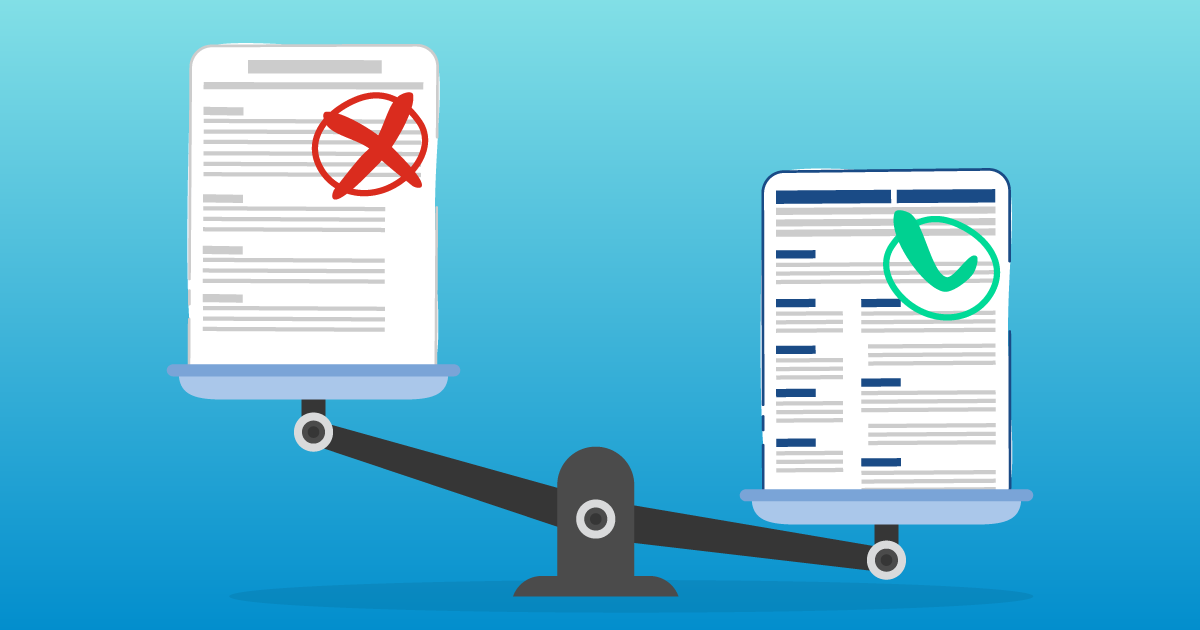
A convincing CV is essential to your job search. It’s the first thing potential employers see and thus their first impression of you. So make sure you nail it in the first go.
Does this sound like a daunting task? Don’t fret, we’ve got your back. In this article we will show you exactly how to write a good CV that will get you noticed. But first we need to get a few definitions in place.
You have probably heard of both a resume and a CV. In short, a resume in the US and a CV in the UK are the exact same. But in the US a CV is a longer form of job search document used to apply for academic positions.
Confused? That’s understandable. Think of it like this: In the UK french fries are called chips. And chips are called crisps. They’re the same thing only with different names. See our article CV vs. resume for further clarification.
If you want to write a resume instead of a CV read our guide on how to write a resume.
Okay, enough of this. Let’s move on to our guide on how to write a CV for a job application in the UK.
How to write a good CV - 10 steps
Writing a CV is kind of like following a recipe. There are variations for how to do it but the end-goal is the same: To land job interviews and get hired.
Below is a clear and short step by step guide to write a good CV. Each step will be explained in detail with tips and tricks. You can click on each individual step that you want to read about.
- Choose your UK CV format
- Write your CV headline (customise it to the job ad)
- Add your contact information
- Write a short and catchy CV summary (customise it to the job ad)
- Add all your relevant work experience in a reverse chronological order (meaning you list your most recent job in the beginning of your CV)
- Make sure to use power words and correct key words
- Add your latest education (keep it at max. two levels)
- Add your skills to your CV (customise them to the job ad)
- Optional: Relevant additional sections such as volunteer work
- Supplement your CV with a cover letter

Choose your UK CV format
The CV format you choose should be based on your level or type of work experience. As it is, we have created an entire blog article on CV formats that you can read.
There are three major CV formats you can choose from. Which one you choose depends on your situation:
- The reverse chronological CV format: This is by far the most popular CV format and the one employers are most familiar with. Choose this format if you have extensive relevant work experience.
- The functional (skill based) CV format: This CV format is ideal if you’re making a career change or if you lack relevant work experience.
- The hybrid (combination) CV format: With this CV format you get the best from each world. Choose this format if you have relevant skills but no extensive work experience yet.
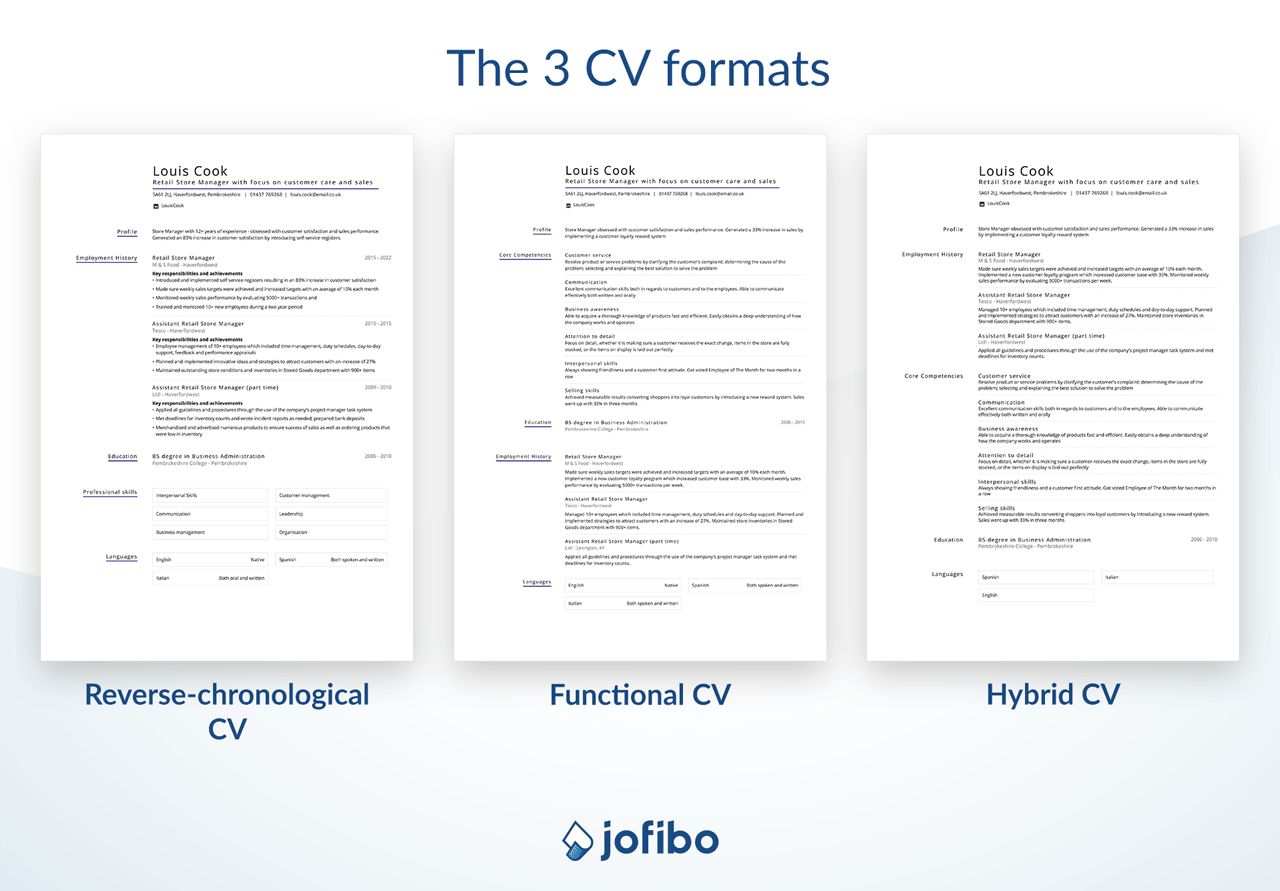
For most job applications you should go for the reverse-chronological CV format since this is the CV format that most clearly shows how your career has progressed over time. For that reason the rest of this guide will focus on a CV with this format.
For many people it is easier to use a CV template to create their CV. This takes the hassle of having to deal with tools like Word which can be especially frustrating if you want to make a two-column CV.
There are many CV templates out there on the world wide web. Now, I don’t want to toot our own horn more than necessary but if you ask me we have some of the best UK CV templates right here.
Write your CV headline
After deciding on a UK CV format it’s time to move on to your CV’s content. We’ll start with an easy one; your headline.
Your headline consists of your name and your professional title. However, you should always tailor your CV headline to the job position in question. Here’s why:
Some larger companies use applicant tracking systems. By being strategic with your professional titles you maximise your chances of them recognizing you as a strong candidate. For example, if the company is looking for a Marketing Manager, but your previous title was Marketing Executive, you write Marketing Manager.
One of the points you’ll see me bring out several times throughout the article is that you have to tailor your CV according to the job position. That means you should always create a new CV for each job application and never just reuse an old one. Recruiters see right through that and it will not give you any points.
Add your contact information
Next up is adding your contact information to your CV.
Your contact information should be placed below your CV’s headline. In our CV templates you don’t need to worry about that - the templates will automatically take care of the CV design for you. You should include the following information:
- Email address (make sure it’s appropriate and professional)
- Phone number
- Optional: Physical address (street name, zip code, city, country) - consider just adding your town and county
- If you have a personal website like an online portfolio this is also where you should place it
Recruiters recommend that you do not add a photo to your CV.
It’s also an option to add your social media accounts such as LinkedIn to your contact information but keep in mind that you invite the recruiter to look at them. So be sure that all your social media content is sober if you choose to add your profiles to your CV. We recommend only adding your LinkedIn profile here.
Write a short and catchy CV summary
Your CV summary’s first and foremost task is to grab the attention of the hiring manager. It has to be precise and go straight to the point. Here’s the deal: Think of your CV summary, or CV profile, as the elevator pitch of your CV. It should only be about 2-3 sentences long or max. 50 words. That’s not much.
Now, how do you go about that? A great tip is to include elements such as:
- Years of experience
- Tailor your CV summary by adding keywords from the job ad
- A sentence telling how you can make a difference and what you can do for them
- Quantifiable achievements related to the position at hand
This part is by far one of the most difficult sections when you write your CV. Sometimes it’s easier to write the summary as the last thing after you have added all your work experience and you have the full overview yourself.
With that in mind your CV summary could look something like this:

Relevant work experience
It’s now time to add in the most important part of your CV; your work experience. This is where you show your qualifications for the job.
You may be tempted to just go ahead and add all of your previous work history because to you it all seems relevant. But here’s the kicker: it isn’t! At least not to the hiring manager.
You need to be selective about which work experiences you want to feature for each position you apply to. The key here is the word “relevant”. When you add your work experience to your CV make sure you only include the relevant experiences. And don’t go back more than 10 years. It’s better to have a few relevant professional experiences than a tangle of odd jobs here and there with no relevance to the job you’re applying for.
You will want to make sure that your CV follows a logical and informative template. Do this by following a reverse-chronological order. This means you need to add your most recent at the top and work your way backwards to your least recent at the bottom.
For each work experience you add to your CV make sure you’ve optimised it as much as possible for the job ad. That means you need to use the same terms as in the job ad wherever possible - eg. professional title.
It’s a good idea to use bullets to highlight your professional experience, results and achievements. Hiring managers love this. If you have any quantifiable results, make sure you use them as much as possible. This will make your CV much easier to read.
Build each work experience using this formula:
- Your title
- Company name
- Company location (city and state)
- Dates of employment (month and year)
If you’re still currently working at a company, you can simply write “[month], [year]–present” for the employment dates.
[When you use a CV maker like Jofibo this is automatically formatted for you so you don’t have to worry about keeping it neat].
Include about 3–5 bullet points containing your main duties, results and achievements working in that role with this formula:
- Start your bullet point with an action verb
- Add a quantifiable point
- Mention a specific and relevant job duty and quantifiable result if possible
Like this:
- Managed a team of 12 employees. Provided positive feedback and annual reviews resulting in an efficiency increase of 37% measured on fewer sick days
- Created marketing materials and publicised events through social media. Increased attendance at several events by 75%
To create an even better work experience section it may be a good idea to check out the STAR method. With this method, you can show how your qualifications benefit the company you’re applying to, rather than just listing them.
Don’t have a lot of work experience yet? Don’t worry; check out how to write a resume with no experience.
Use power words and correct key words
It should be very clear now that it’s essential that you tailor each CV that you write to the job position at hand. One easy way to do this is by simply using some of the same terms and words that they use themselves. Here’s how:
- Thoroughly read through the job ad and highlight the skills and professional experiences that the company is looking for in a candidate
- Use these exact same words in the description of you, your skills, and work experience in your CV
But that’s not all though. In order to really spice up your CV you should also add in some nice power words. These words will make your CV come alive and will make you appear both confident and competent.
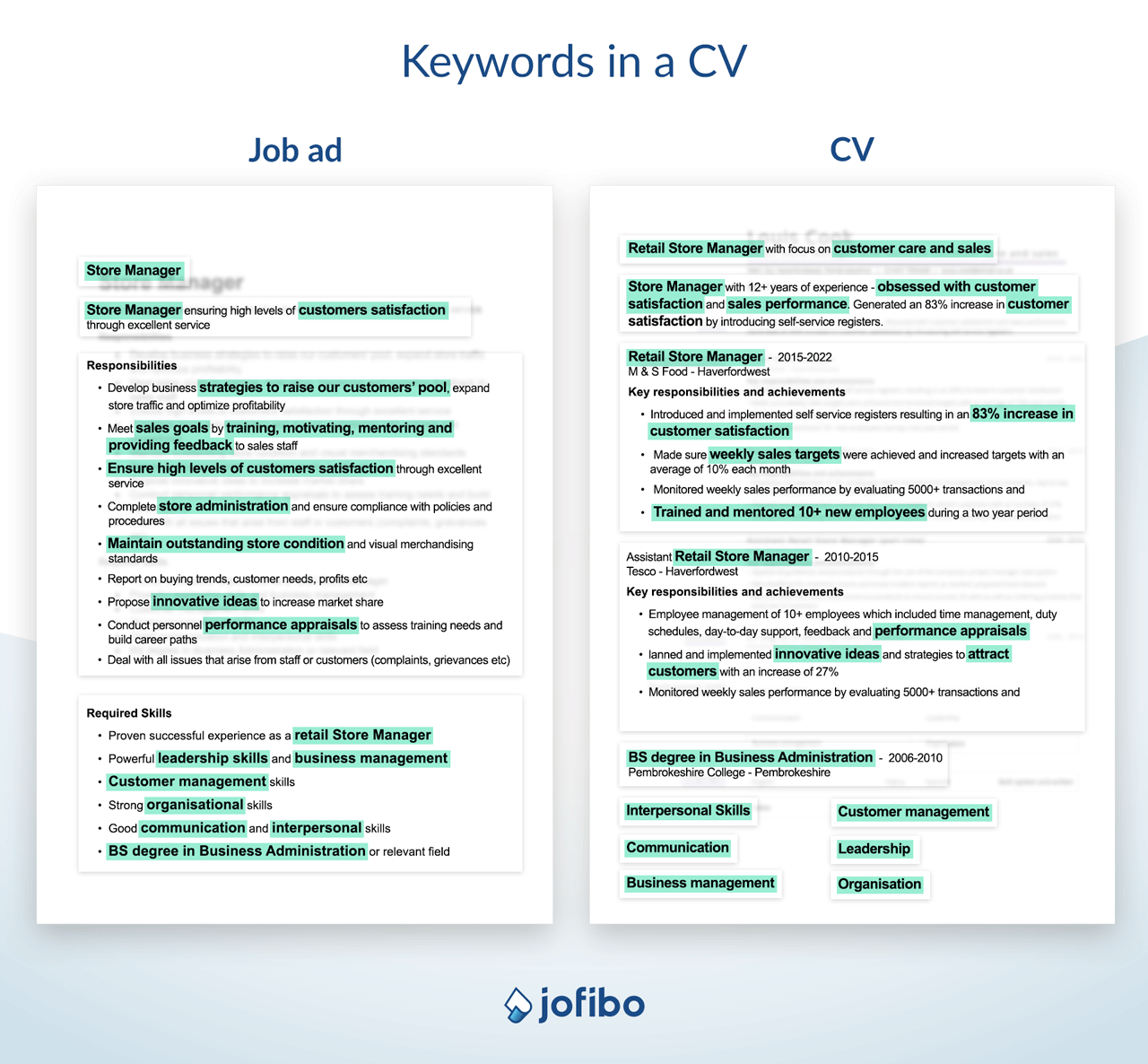
Education
Now, you can’t write a good CV without a solid education section. This is vital in showing your potential employer that you have the necessary skills and knowledge to excel in the position you are applying for. Just don’t add all your education from primary and secondary education. Only add your latest finished degree and any relevant courses and certificates you’ve attained, and don’t add more than two levels of education. The key is to keep it relevant.
Here is how you should add your education to a standard education section:
- Your major
- The name of your university, community college, or technical school
- Location of the school (city, state)
- Date of graduation (month, year)
Here’s how it looks “behind the scenes” in our CV maker:
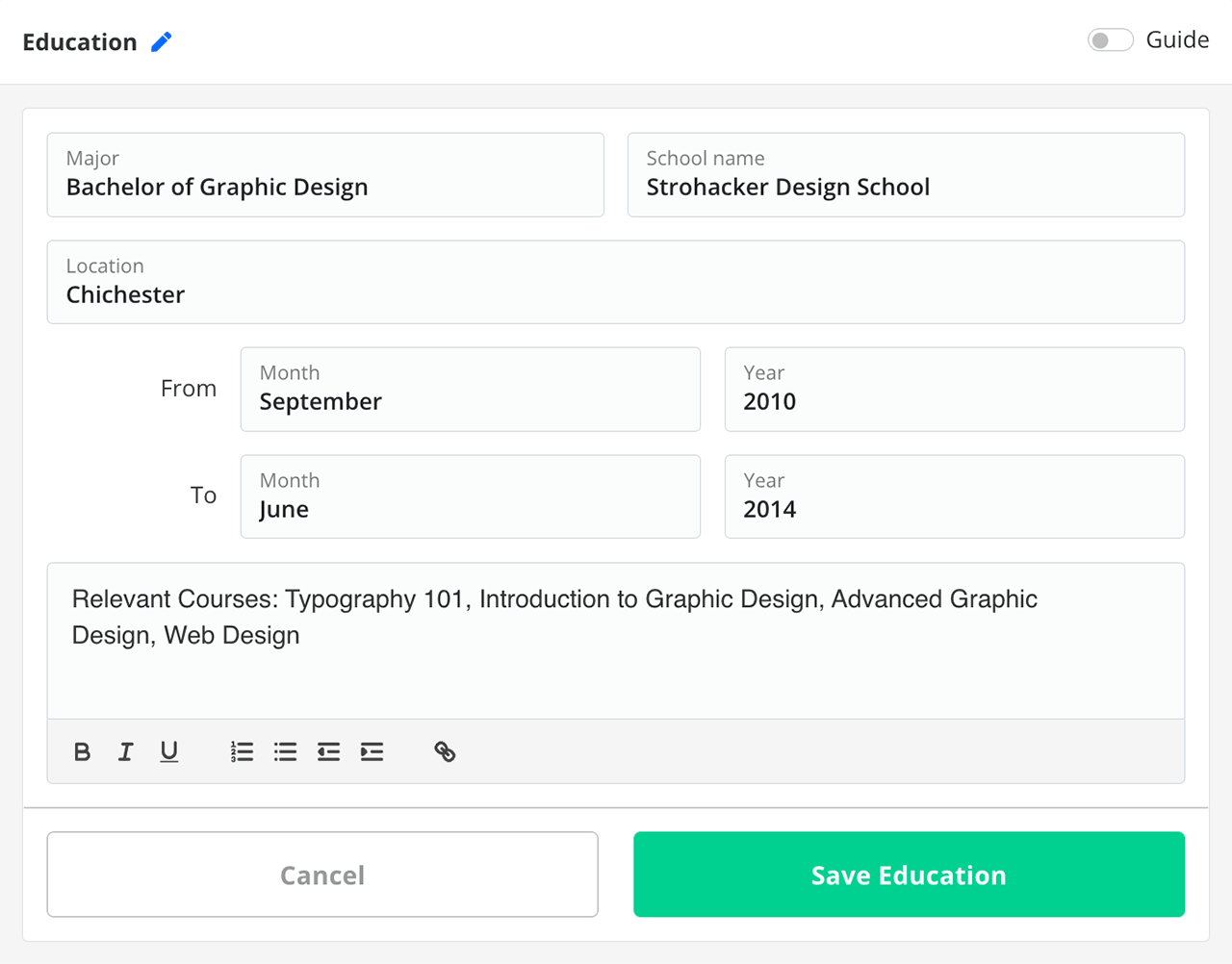
As you can see it’s just a matter of entering your data and you’re all set. The outcome looks like this:

Adding skills to your CV
Adding skills to your CV can be a bit of a challenge. On the one hand you know you possess many of the skills the hiring manager is looking for but on the other hand you have no idea how to showcase them effectively on your CV.
So, how do you actually show off your skills on a CV? Well, there are some different ways depending on what CV format you’re going for. Their role also changes depending on where in your career you are at the moment.
The most obvious way to showcase your skills on your CV is by implementing them into your CV summary and in your work experience. In our CV templates there are also dedicated skill sections where you can add them. These sections are particularly suitable to showcase any technical skills or software skills you may have.
When we talk about skills we often differentiate between soft skills and hard skills.
Your hard skills are the quantifiable, job-specific abilities that you learn through education, training or through your work experience. Language skills, computer skills and being able to handle heavy machinery are all examples of industry specific hard skills.
Soft skills, or interpersonal skills as well, on the other hand, are the skills that are a part of your personality. They are the personal characteristics that positively influence how you work and interact with other people. These skills are not easily taught in a classroom. Skills such as verbal and non-verbal communication, problem solving and critical thinking are all examples of soft skills that are highly valued by most employers.
Optional: Relevant additional sections
If you have any alternative experience that is relevant to the position you are applying for, you should go ahead and add them to your CV. But keep in mind that it needs to be obvious why you are adding them. This section is completely optional and is often better left out.
Relevant additional sections could be:
- Language skills
- Volunteer work
- Awards and recognitions
- Certificates
- Projects
- Charity work
In our CV maker you will find a selection of predefined additional sections. You can also create your own custom section if needed.
Supplement your CV with a cover letter
The necessity of writing a cover letter is a subject that often sparks controversy. Some think it’s definitely necessary while others don’t. There’s no right or wrong answer here unfortunately and sometimes it depends on the position at hand.
As a general rule we advise you to write a cover letter to supplement your CV. It may not get read in the first round but if you make it past the initial screening the hiring manager is sure to read it. So unless it’s specifically mentioned in the job ad to not add a cover letter, you should definitely write one.
Get started on your own CV now - just click the button below to go to our UK CV templates.
What is a CV? Good CV examples
Now then, what is a good CV? Sometimes it’s just easier to look at some good CV examples to get an idea of what a good CV looks like. So that’s what we’re giving you here.
All three CV examples are made with the CV templates in our CV maker.
Project Manager CV example
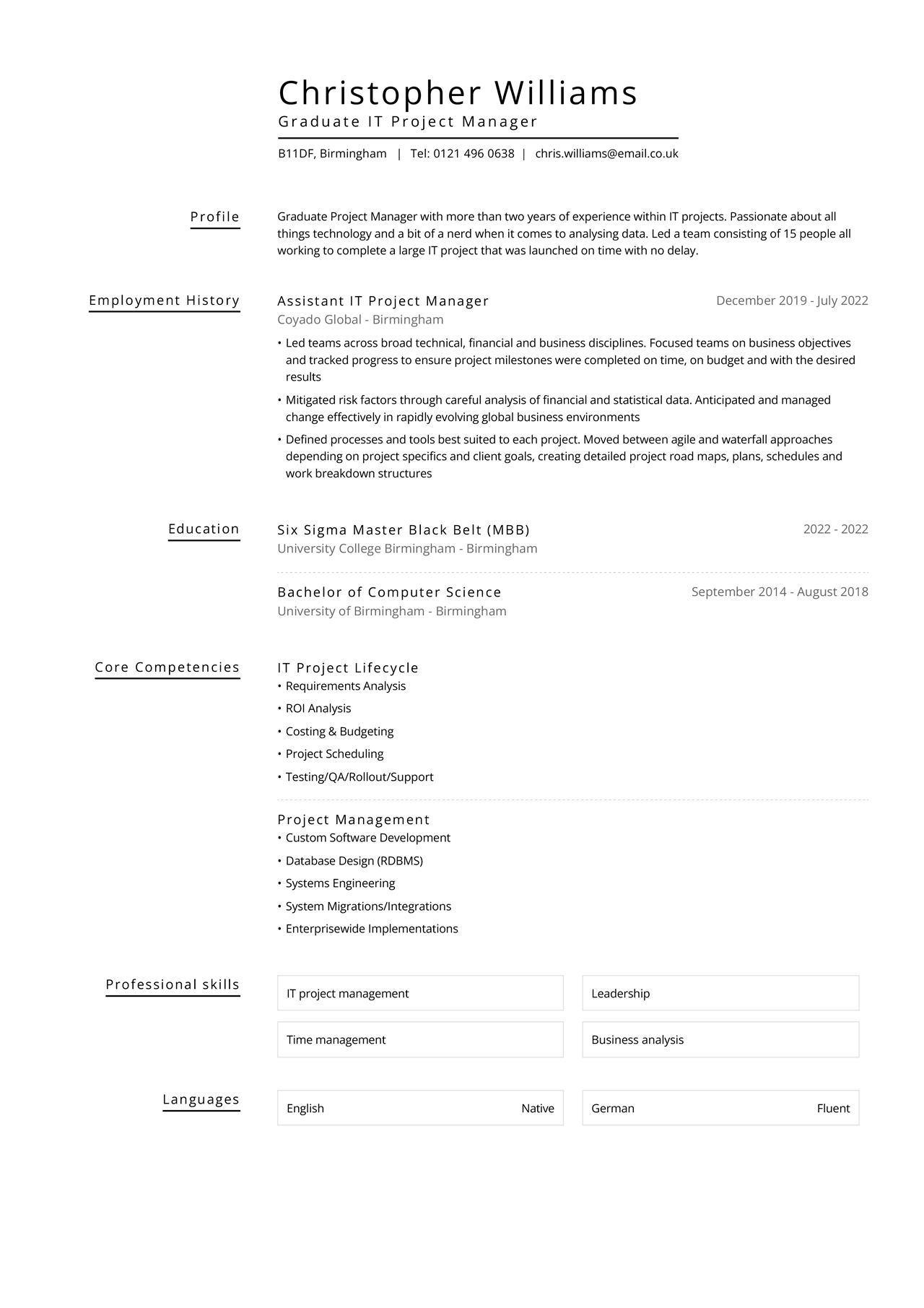
Graphic Designer CV example
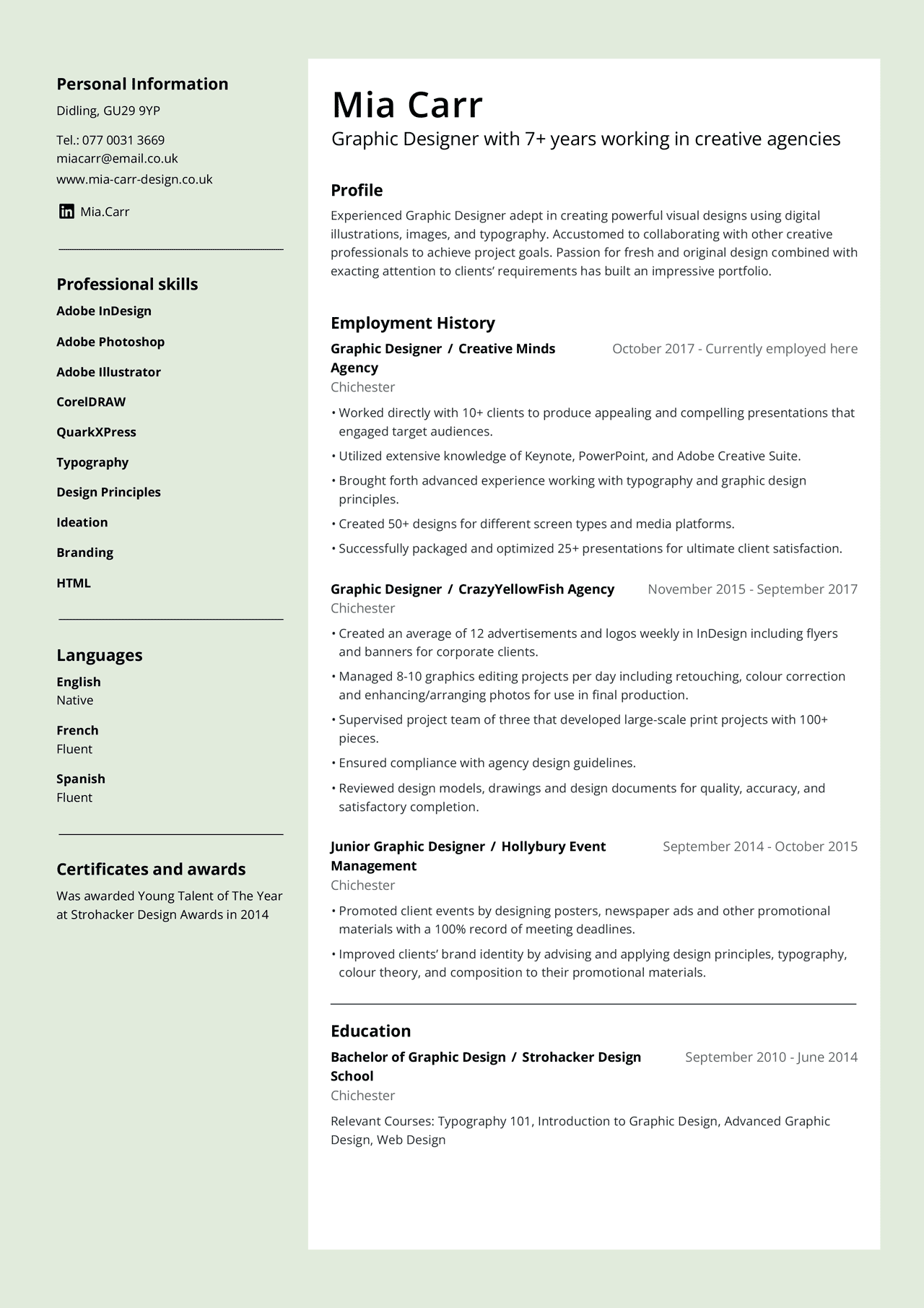
Digital Marketing CV example
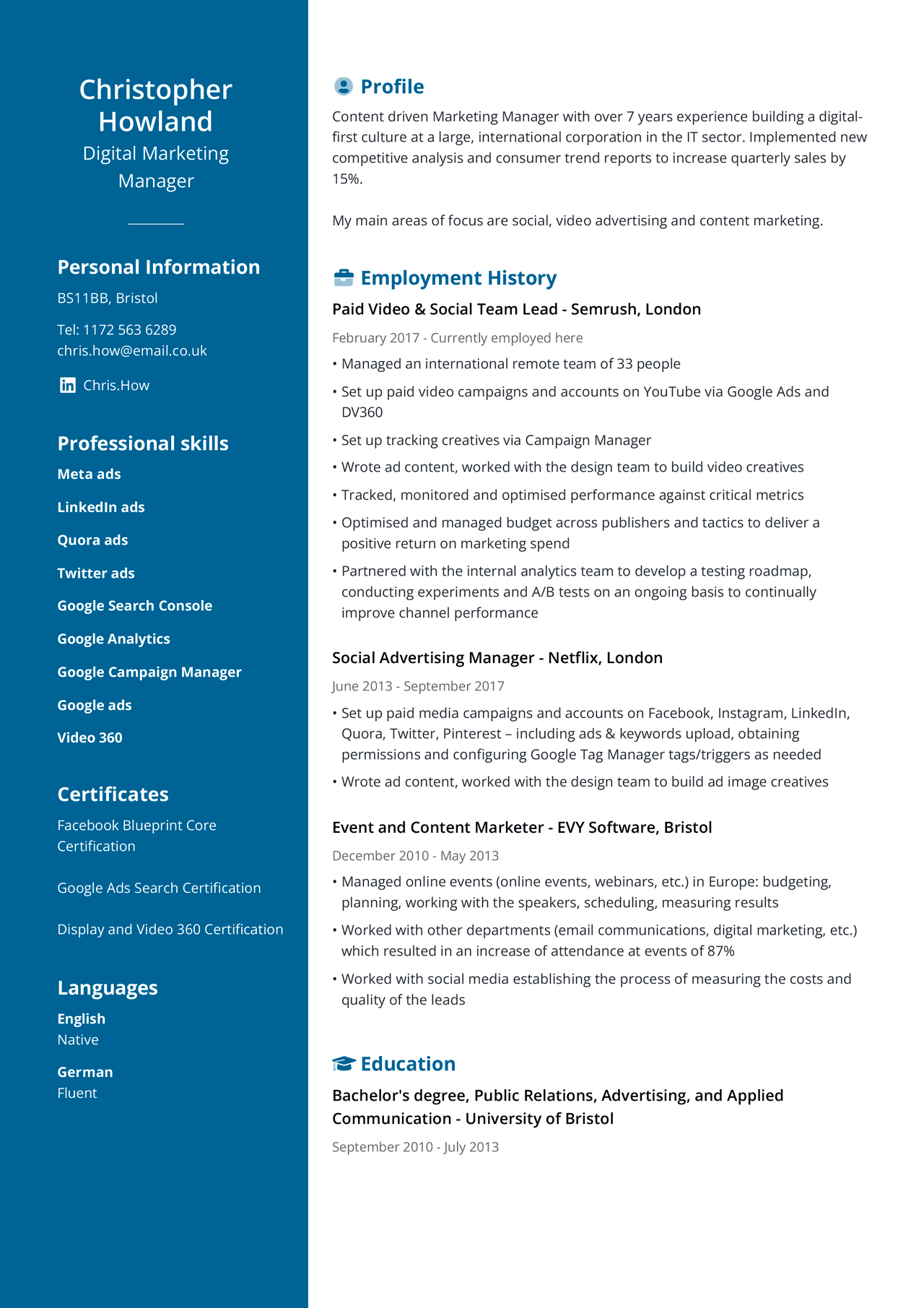
How to write a CV with no experience
Not everyone has a lot of professional experience to bring to the table. Perhaps you’re recently graduated or you’re shifting your career. In either case you will need to focus on something else in your CV than your lack of experience. Want to know the best part? It’s easier than you think.
Here’s how you go about it:
- Analyse the job ad and mark relevant CV keywords (words and phrases that describe the desired qualities in a candidate)
- Find situations where you have shown these qualities. They could be part-time jobs, internships, projects, volunteer work, relevant hobbies or interests
- List your soft skills and hard skills that are transferable and relevant to the position. A transferable skill is a skill you can use in multiple employments no matter the industry, for instance good communication skills
- Add any additional sections you deem relevant
- Write your CV summary emphasising on your unique skill set and dedication

![20 Best Questions to Ask an Interviewer [2025]](https://jofibostorage.blob.core.windows.net/blog/InterviewQuestions1-cover.jpg)
![CV Format Guide for 2025 [With 10+ Examples]](https://jofibostorage.blob.core.windows.net/blog/cv-format-guide-header.png)
